Cite this document
(“Technology in Aircraft Maintenance Essay Example | Topics and Well Written Essays - 1500 words”, n.d.)
Technology in Aircraft Maintenance Essay Example | Topics and Well Written Essays - 1500 words. Retrieved from https://studentshare.org/technology/1539818-technology-in-aircraft-maintenance
Technology in Aircraft Maintenance Essay Example | Topics and Well Written Essays - 1500 words. Retrieved from https://studentshare.org/technology/1539818-technology-in-aircraft-maintenance
(Technology in Aircraft Maintenance Essay Example | Topics and Well Written Essays - 1500 Words)
Technology in Aircraft Maintenance Essay Example | Topics and Well Written Essays - 1500 Words. https://studentshare.org/technology/1539818-technology-in-aircraft-maintenance.
Technology in Aircraft Maintenance Essay Example | Topics and Well Written Essays - 1500 Words. https://studentshare.org/technology/1539818-technology-in-aircraft-maintenance.
“Technology in Aircraft Maintenance Essay Example | Topics and Well Written Essays - 1500 Words”, n.d. https://studentshare.org/technology/1539818-technology-in-aircraft-maintenance.


